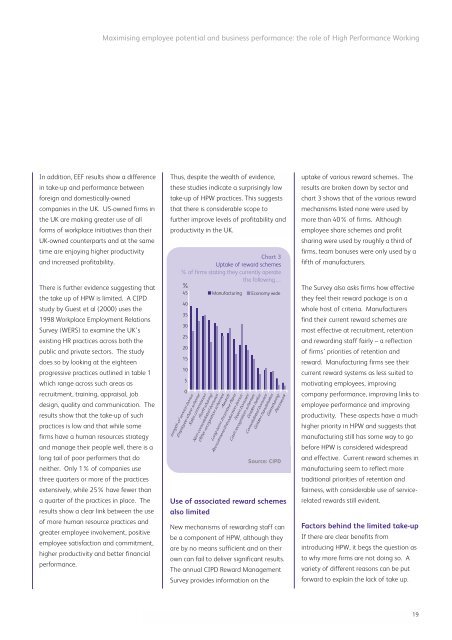About EEF - CIPD
About EEF - CIPD
About EEF - CIPD
Create successful ePaper yourself
Turn your PDF publications into a flip-book with our unique Google optimized e-Paper software.
Maximising employee potential and business performance: the role of High Performance WorkingIn addition, <strong>EEF</strong> results show a differencein take-up and performance betweenforeign and domestically-ownedcompanies in the UK. US-owned firms inthe UK are making greater use of allforms of workplace initiatives than theirUK-owned counterparts and at the sametime are enjoying higher productivityand increased profitability.There is further evidence suggesting thatthe take up of HPW is limited. A <strong>CIPD</strong>study by Guest et al (2000) uses the1998 Workplace Employment RelationsSurvey (WERS) to examine the UK’sexisting HR practices across both thepublic and private sectors. The studydoes so by looking at the eighteenprogressive practices outlined in table 1which range across such areas asrecruitment, training, appraisal, jobdesign, quality and communication. Theresults show that the take-up of suchpractices is low and that while somefirms have a human resources strategyand manage their people well, there is along tail of poor performers that doneither. Only 1% of companies usethree quarters or more of the practicesextensively, while 25% have fewer thana quarter of the practices in place. Theresults show a clear link between the useof more human resource practices andgreater employee involvement, positiveemployee satisfaction and commitment,higher productivity and better financialperformance.Thus, despite the wealth of evidence,these studies indicate a surprisingly lowtake-up of HPW practices. This suggeststhat there is considerable scope tofurther improve levels of profitability andproductivity in the UK.Chart 3Uptake of reward schemes% of firms stating they currently operatethe following…%45 Manufacturing Economy wide4035302520151050AwardsLong-term Incentive PlansRecruitment/Introduction bonusTeam bonusesCash recognition schemesGolden hellosConsolidated bonusesLength of service bonusEmployee share schemeSales commissionProfit-sharingNon-consolidated bonusesOther recognition schemesGolden handshakesGainsharingPieceworkSource: <strong>CIPD</strong>Use of associated reward schemesalso limitedNew mechanisms of rewarding staff canbe a component of HPW, although theyare by no means sufficient and on theirown can fail to deliver significant results.The annual <strong>CIPD</strong> Reward ManagementSurvey provides information on theuptake of various reward schemes. Theresults are broken down by sector andchart 3 shows that of the various rewardmechanisms listed none were used bymore than 40% of firms. Althoughemployee share schemes and profitsharing were used by roughly a third offirms, team bonuses were only used by afifth of manufacturers.The Survey also asks firms how effectivethey feel their reward package is on awhole host of criteria. Manufacturersfind their current reward schemes aremost effective at recruitment, retentionand rewarding staff fairly – a reflectionof firms’ priorities of retention andreward. Manufacturing firms see theircurrent reward systems as less suited tomotivating employees, improvingcompany performance, improving links toemployee performance and improvingproductivity. These aspects have a muchhigher priority in HPW and suggests thatmanufacturing still has some way to gobefore HPW is considered widespreadand effective. Current reward schemes inmanufacturing seem to reflect moretraditional priorities of retention andfairness, with considerable use of servicerelatedrewards still evident.Factors behind the limited take-upIf there are clear benefits fromintroducing HPW, it begs the question asto why more firms are not doing so. Avariety of different reasons can be putforward to explain the lack of take up.19
















